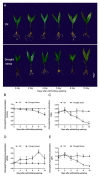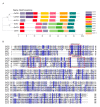Overexpression of a Gene Encoding Trigonelline Synthase from Areca catechu L. Promotes Drought Resilience in Transgenic Arabidopsis
- PMID: 35214824
- PMCID: PMC8877179
- DOI: 10.3390/plants11040487
Overexpression of a Gene Encoding Trigonelline Synthase from Areca catechu L. Promotes Drought Resilience in Transgenic Arabidopsis
Abstract
Areca catechu L. is a commercially important palm tree widely cultured in tropical and subtropical areas. Its growth and production are severely hindered by the increasing threat of drought. In the present study, we investigated the physiological responses of areca seedlings to drought stress. The results showed that prolonged drought-induced yellowing on the overall area of most leaves significantly altered the chlorophyll fluorescence parameters, including maximum chemical efficiency (Fv/Fm), photochemical efficiency of PSII (Y(II)), photochemical chlorophyll fluorescence quenching (qP) and non-photochemical chlorophyll fluorescence quenching (NPQ). On the 10th day of drought treatment, the contents of proline in the areca leaves and roots increased, respectively, by 12.2 times and 8.4 times compared to normal watering. The trigonelline levels in the leaves rose from 695.35 µg/g to 1125.21 µg/g under 10 days of water shortage, while no significant changes were detected in the content of trigonelline in the roots. We determined the gene encoding areca trigonelline synthase (AcTS) by conducting a bioinformatic search of the areca genome database. Sequence analysis revealed that AcTS is highly homologous to the trigonelline synthases in Coffea arabica (CaTS 1 and CaTS 2) and all possess a conserved S-adenosyl- L-methionine binding motif. The overexpression of AcTS in Arabidopsis thaliana demonstrated that AcTS is responsible for the generation of trigonelline in transgenic Arabidopsis, which in turn improves the drought resilience of transgenic Arabidopsis. This finding enriches our understanding of the molecular regulatory mechanism of the response of areca to water shortage and provides a foundation for improving the drought tolerance of areca seedlings.
Keywords: areca seedling; drought resilience; gene expression; trigonelline synthase.
Conflict of interest statement
The authors declare that the research was conducted in the absence of any commercial or financial relationships that could be construed as a potential conflict of interest.
Figures





Similar articles
-
Interactive effects of drought stresses and elevated CO2 concentration on photochemistry efficiency of cucumber seedlings.J Integr Plant Biol. 2008 Oct;50(10):1307-17. doi: 10.1111/j.1744-7909.2008.00686.x. J Integr Plant Biol. 2008. PMID: 19017118
-
[Effects of drought and rewatering on leaf photosynthesis, chlorophyll fluorescence, and root architecture of citrus seedlings.].Ying Yong Sheng Tai Xue Bao. 2018 Aug;29(8):2485-2492. doi: 10.13287/j.1001-9332.201808.028. Ying Yong Sheng Tai Xue Bao. 2018. PMID: 30182586 Chinese.
-
Monitoring of Salinity, Temperature, and Drought Stress in Grafted Watermelon Seedlings Using Chlorophyll Fluorescence.Front Plant Sci. 2021 Dec 22;12:786309. doi: 10.3389/fpls.2021.786309. eCollection 2021. Front Plant Sci. 2021. PMID: 35003172 Free PMC article.
-
Leaf Age-Dependent Photosystem II Photochemistry and Oxidative Stress Responses to Drought Stress in Arabidopsis thaliana Are Modulated by Flavonoid Accumulation.Molecules. 2021 Jul 8;26(14):4157. doi: 10.3390/molecules26144157. Molecules. 2021. PMID: 34299433 Free PMC article.
-
[Effects of drought on leaf growth and chlorophyll fluorescence kinetics parameters in Cyclobalanopsis glauca seedlings of Karst areas].Ying Yong Sheng Tai Xue Bao. 2019 Dec;30(12):4071-4081. doi: 10.13287/j.1001-9332.201912.001. Ying Yong Sheng Tai Xue Bao. 2019. PMID: 31840451 Chinese.
Cited by
-
Metabolome Profiling and Predictive Modeling of Dark Green Leaf Trait in Bunching Onion Varieties.Metabolites. 2025 Mar 26;15(4):226. doi: 10.3390/metabo15040226. Metabolites. 2025. PMID: 40278355 Free PMC article.
-
Selenium nanoparticles enhance metabolic and nutritional profile in Phaseolus vulgaris: comparative metabolomic and pathway analysis with selenium selenate.BMC Plant Biol. 2025 Jan 28;25(1):119. doi: 10.1186/s12870-025-06097-6. BMC Plant Biol. 2025. PMID: 39871137 Free PMC article.
-
Exploring Antioxidant and α-Glucosidase Inhibitory Activities in Mulberry Leaves (Morus alba L.) across Growth Stages: A Comprehensive Metabolomic Analysis with Chemometrics.Molecules. 2023 Dec 27;29(1):171. doi: 10.3390/molecules29010171. Molecules. 2023. PMID: 38202754 Free PMC article.
-
Elucidation of Physiological, Transcriptomic and Metabolomic Salinity Response Mechanisms in Medicago sativa.Plants (Basel). 2023 May 22;12(10):2059. doi: 10.3390/plants12102059. Plants (Basel). 2023. PMID: 37653976 Free PMC article.
References
-
- Chávez-Arias C.C., Ligarreto-Moreno G.A., Ramírez-Godoy A., Restrepo-Díaz H. Maize responses challenged by drought, elevated daytime temperature and arthropod herbivory stresses: A physiological, biochemical and molecular view. Front. Plant Sci. 2021;12:702841. doi: 10.3389/fpls.2021.702841. - DOI - PMC - PubMed
Grants and funding
LinkOut - more resources
Full Text Sources
Miscellaneous

